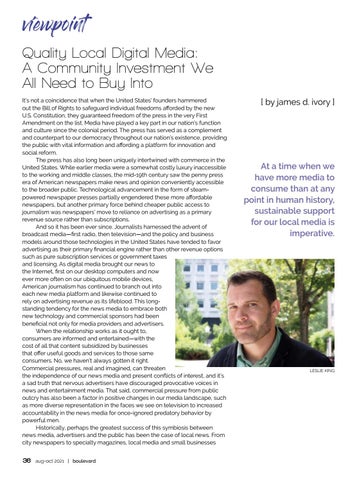viewpoint Quality Local Digital Media: A Community Investment We All Need to Buy Into It’s not a coincidence that when the United States’ founders hammered out the Bill of Rights to safeguard individual freedoms afforded by the new U.S. Constitution, they guaranteed freedom of the press in the very First Amendment on the list. Media have played a key part in our nation’s function and culture since the colonial period. The press has served as a complement and counterpart to our democracy throughout our nation’s existence, providing the public with vital information and affording a platform for innovation and social reform. The press has also long been uniquely intertwined with commerce in the United States. While earlier media were a somewhat costly luxury inaccessible to the working and middle classes, the mid-19th century saw the penny press era of American newspapers make news and opinion conveniently accessible to the broader public. Technological advancement in the form of steampowered newspaper presses partially engendered these more affordable newspapers, but another primary force behind cheaper public access to journalism was newspapers’ move to reliance on advertising as a primary revenue source rather than subscriptions. And so it has been ever since. Journalists harnessed the advent of broadcast media—first radio, then television—and the policy and business models around those technologies in the United States have tended to favor advertising as their primary financial engine rather than other revenue options such as pure subscription services or government taxes and licensing. As digital media brought our news to the Internet, first on our desktop computers and now ever more often on our ubiquitous mobile devices, American journalism has continued to branch out into each new media platform and likewise continued to rely on advertising revenue as its lifeblood. This longstanding tendency for the news media to embrace both new technology and commercial sponsors had been beneficial not only for media providers and advertisers. When the relationship works as it ought to, consumers are informed and entertained—with the cost of all that content subsidized by businesses that offer useful goods and services to those same consumers. No, we haven’t always gotten it right. Commercial pressures, real and imagined, can threaten the independence of our news media and present conflicts of interest, and it’s a sad truth that nervous advertisers have discouraged provocative voices in news and entertainment media. That said, commercial pressure from public outcry has also been a factor in positive changes in our media landscape, such as more diverse representation in the faces we see on television to increased accountability in the news media for once-ignored predatory behavior by powerful men. Historically, perhaps the greatest success of this symbiosis between news media, advertisers and the public has been the case of local news. From city newspapers to specialty magazines, local media and small businesses
36
aug-oct 2021 | boulevard
[ by james d. ivory ]
At a time when we have more media to consume than at any point in human history, sustainable support for our local media is imperative.
LESLIE KING











